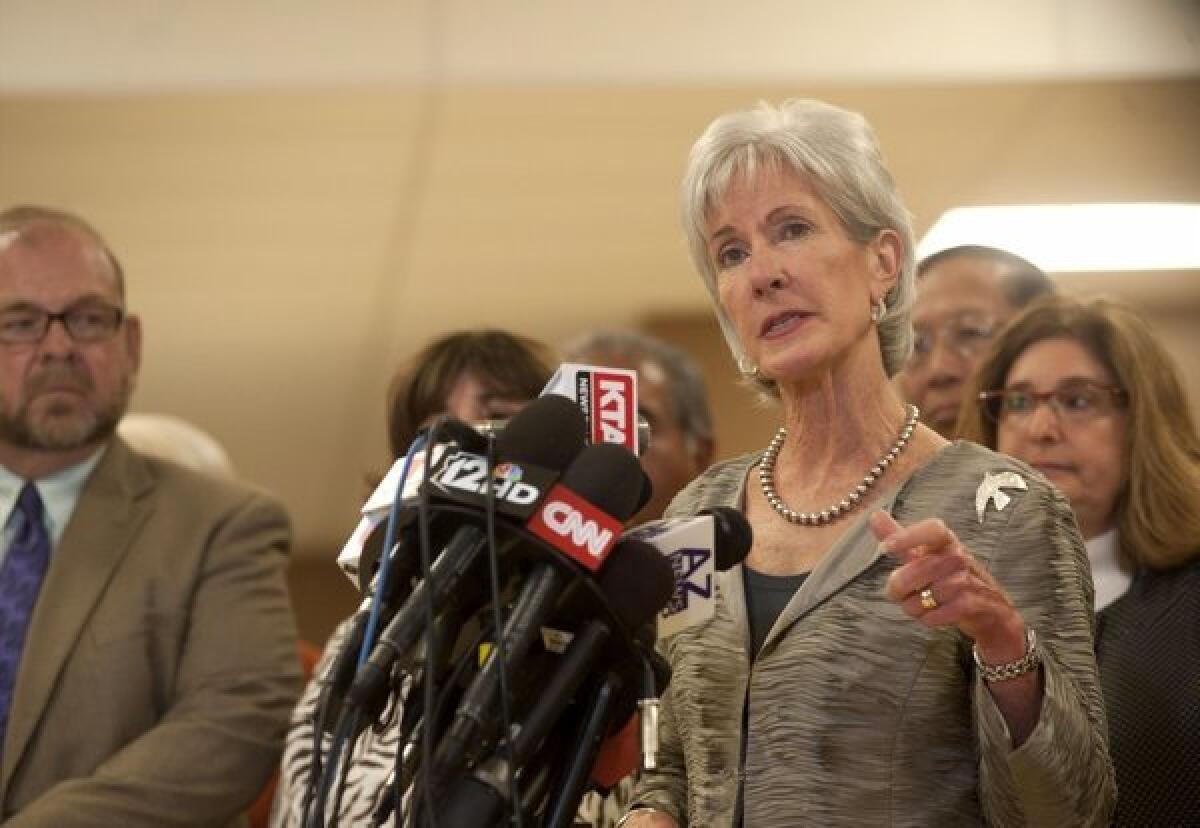Separating the day’s myths and realities on Obamacare

Developments in the rollout of Obamacare are coming with dizzying speed, though not as fast as the pileup of fiction and misunderstanding created by politicians, pundits and the news media. So here’s a list of the latest themes you’re hearing on America’s healthcare reform, and what they mean.
1. Obama “knew” that people would lose their health insurance. This story, chiefly promoted by NBC News, reflects the Washington media’s eternal search for scandal, abetted by every politician’s instinct to reduce even the most complicated ideas to a sound byte.
It was always clear that many insurance policies serving the individual market wouldn’t conform to the coverage requirements set by the Affordable Care Act and would have to be changed. Some were “grandfathered” in, but the rules dictated that any that were changed by the insuring companies -- including changes in premiums or other terms -- would lose that status.
As a result, millions of policyholders are now being informed that their nonconforming policies are being canceled as of Dec. 31. The idea, of course, is for them to get new policies under Obamacare as of Jan. 1. NBC is breathing heavily over its investigative “discovery” that “because of normal turnover in the individual insurance market, 40 to 67% of customers will not be able to keep their policy” mostly because they changed plans.
But is this news? No: The exact same figure was put out by the Obama Adminsitration -- in 2010. Here’s a release from the Department of Health and Human Services from June that year, explaining that “40% to two-thirds of people” in the individual market normally change plans in a year, and thus would no longer be in grandfathered plans. Did Obama “know”? Yes, but so did anyone else who was paying attention, including reporters covering healthcare.
2. Premium “sticker shock.” As my colleague Chad Terhune vividly reported, some individuals whose old policies are being canceled because they don’t meet Obamacare standards are facing higher premiums in the new exchange-based marketplace.
While that’s true, it comes with a couple of sizable “buts.” For one thing, the higher premiums quoted by Obamacare critics often don’t factor in the premium subsidies available to lower-income individuals and families under Obamacare. The subsidies cover those earning less than 400% of the federal poverty limit; for those earning less than 250%, the law offers subsidies both for premiums and for out-of-pocket costs. So premium subsidies are payable for, say, a family of four earning less than $94,200, and the out-of-pocket aid is offered to families of four earning less than $58,875.
Another aspect is that the new policies typically are more worthwhile than the old. Consider the case of Dianne Barrette, a Florida woman who told CBS News that her old policy, which cost $50 a month, was canceled and her only alternative was new coverage costing more than $500 a month. Unsurprisingly, Barrette got heavily booked by Fox News to tell her story.
But as Erik Wemple of the Washington Post determined, her old policy was a tattered thing that doesn’t even cover hospitalization; all new policies do. Under her old policy, even a brief hospitalization would put this 56-year-old in the poorhouse. Nor did Barrette apparently check out the availability of alternative policies or subsidies; according to my research, a fully compliant Obamacare policy could cost her as little as $209 a month. Plus it’s almost certain to have lower co-pays, deductibles and out-of-pocket limits than her “cheap” $50 plan. CBS didn’t bother to report how her old plan and new options differ. That’s too bad, since for all we know Barrette is going to be much better off come Jan. 1.
3. The website debacle. This is a genuine problem, although the administration’s new Obamasite guru, Jeff Zients, says the federal website, which serves the insurance exchanges of three dozen states, will be fully functional by Nov. 30.
But treating the website’s woes as a sign of the Affordable Care Act’s shortcomings is a huge leap. Several states that took the initiative to create their own exchanges -- which the act encouraged -- are doing far better. The gold standard, interestingly enough, is set by Kentucky, which already has enrolled 26,000 of its 625,000 uninsured residents in coverage for 2014. That’s a significant achievement, and it’s a testament to Democratic Gov. Steve Beshear’s determination to overcome efforts by the Republican-controlled state legislature to hobble the effort.
Also doing well is Washington state, which enrolled 49,000 residents through Oct. 25 at a rate that seems to be picking up over time. California’s site, surprisingly, is experiencing considerable growing pains despite the state’s enthusiastic embrace of Obamacare; the state exchange has reported that 126,000 applications were started as of Oct. 21, but it won’t report any other statistics until next month.
Like other successful states, Washington and Kentucky are enrolling applicants in commercial insurance and Medicaid, which was expanded by the Affordable Care Act largely at federal expense for states that choose to accept it. The federal website serves states that chose not to establish their own exchanges, which overlap heavily with those that turned down the Medicaid expansion, thereby creating a double whammy for residents.
Not coincidentally, those holdout states tend to be the ones with the highest proportions of uninsured residents. Call it, then, a triple whammy. Don Taylor of Duke University has tracked what he terms the wealth transfer from poor states to rich states as a result of the formers’ short-sighted refusal to expand Medicaid. (H/t Kevin Drum.) Thus far, 24 states and D.C. are on board and 21 have refused, with six still on the fence. Taylor figures that the expanding states will receive $30.3 billion additional federal dollars in 2016. The refuseniks are giving up $35 billion; in technical terms, that’s known as brainlessness in the statehouse.
Many people are fretting that the website woes will discourage younger, healthier Americans from signing up for insurance, leaving the insured pool overstocked with older, sicker and therefore costlier customers. That may be so -- we won’t know until more facts are in, possibly months from now -- but fears of a “death spiral” in premiums are overwrought. As we reported last week, the Affordable Care Act has a relief valve built in: a risk adjustment process that covers part of the costs for insurance carriers that end up with an unexpectedly high share of costly risks. The dysfunction of healthcare.gov may throw the risk profiles of some insurers out of whack, but it won’t crash Obamacare.
Have an Obamacare story, good or bad? Share it with me.
More to Read
Inside the business of entertainment
The Wide Shot brings you news, analysis and insights on everything from streaming wars to production — and what it all means for the future.
You may occasionally receive promotional content from the Los Angeles Times.











